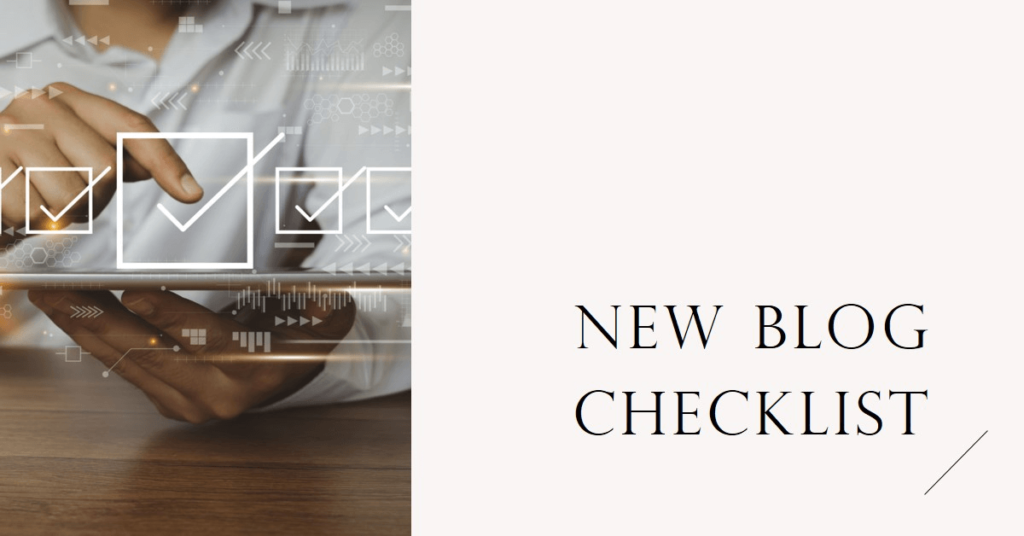If you’re thinking about starting a new blog, there are a few things you need to consider first. From finding your niche and audience to reliable hosting to optimizing your content for better performance, you need to go through every step to be successful.
Check out our new blog checklist and find out what you need to do before starting a blog. Spending extra time on the new blog checklist can help ensure that you create a blog that reaches many readers and has a lot of traffic.
New blog checklist
Before starting a new blog, you must complete the following steps:
Complete the New Blog Checklist
If you find our short list interesting and think you could use some help, we’ve written about each step along the way in more detail below. Read on to learn how to start a blog and what it entails.
Find your niche
You can’t become a doctor if you’ve studied law, can you? The same applies to blogs too. You need to find your niche that includes categories and topics of things that interest you and things that you want to learn more about and are passionate about presenting to your readers.
Suppose you are interested in cars, motorcycles and technology like smartphones, gadgets, computers etc. You could start a blog on these topics but you could also publish articles about tech gadgets and computers in newer cars or bikes, what would be more interesting, than just writing about cars.
Learn more about your target audience
Before you start writing articles, you need to figure out who you are writing them for, namely your target audience. If you want your blog to be successful and get a lot of traffic, you need to research and analyze your target audience and find out as much as possible about them.
If you’re writing for the wrong audience, no amount of keywords, marketing, and advertising will help you. No matter how good your blog is, how catchy your titles are, and how informative your articles are, it will feel like you are talking to a wall.
Set yourself clear goals
Once you’ve found your niche and determined who your readers will be, you can start thinking about what you want to achieve by creating this blog. Is writing about these topics your passion or are you looking for a way to make some money on the side? These goals can be anything related to blogging.
Be realistic about your goals, put them on paper, and add loose deadlines to those goals. For example: “I want to have it by the end of 2023 so many monthly blog visits.”
Don’t set your goals high in the beginning as you are probably a beginner at blogging and it can be a recipe for disappointment and disaster as you are still figuring things out and don’t know how blogging works.
Design your blog correctly
Choosing the right blog platform can make your life a lot easier when starting a blog, but you also need to customize the design elements to suit your style and complement your niche and articles.
Focus on the homepage design, buttons, drop-down menus, fonts, colors, etc. You want your homepage to attract the attention of new visitors and make navigating your site as easy as possible for your existing readers.
Look at Apple for example. A design this clean is much better than something full of buttons, images, and other graphics. Remember that your design elements can affect the responsiveness of your website. This is another reason to keep them simple.
Add your legal documents
After you’ve designed your blog, it’s time to add your legal documents. People often assume that a simple blog doesn’t have to comply with online privacy laws, but that’s not true!
Data protection laws apply to any website that processes personal data, and the definition of personal data is very broad, even including things like IP addresses.
In addition, processing can take place via various elements of your blog, such as the contact form, social media widgets or newsletters.
Compliance is not a one-size-fits-all process, but a simple blog would at least need the following:
- A privacy policy: This is a document that informs your users about your data processing activities. It also explains what rights you have regarding your data and how you can exercise them. If you don’t know where to start, check this out Privacy policy template.
- A cookie consent banner: This is a notice that appears when you first visit your blog, asking for consent to install cookies in your users’ browsers.
You want the privacy policy to be a separate page on your website and cookie consent to be easily given in a number of ways WordPress plugins.
Brainstorm topics
After you’ve figured out your niche and who your audience might be and what you want explained and answered to them, you need to start creating engaging topics that combine these elements.
You can use search engines and see what others are searching for when they search for articles in your niche. This will give you ideas of what to write about and help you brainstorm ideas for your next article.
Determine your branding
Once you know more about what interests you, what you want to write about, and what your audience wants to see, you need to think about your articles, what they say about you, and how you handle certain things.
You want to determine what your brand is about, and that includes things from logos and colors to the fonts, graphics, and style your articles use to the way you talk about things in your copy.
All of this together contributes to creating your brand; The more unique you are, the better it is.
Get reliable hosting
If you have clear goals and know your audience, what you write about and how often, you can effectively determine how many monthly visitors your blog will receive. However, it is always good to plan and think about growth. This way you can figure out which hosting service you need without overpaying.
Research different hosting providers, compare their prices, make a list of popular hosting services in your area, and choose one that’s right for your website. Make sure that such a hosting service has all the features you need and remember to also contact technical support as unexpected disasters can always happen.
Conduct keyword research
Once you have sorted out everything your blog is about, you can start creating content for your blog and write articles on the topics you care about.
However, for these articles to be successful and land on the first page of various search engines, you need to research popular keywords and then incorporate them into your writing.
Various tools like Semrush can help you with this step. By incorporating these keywords, you can increase your blog’s visibility and drive more traffic to your articles.
Set up your blog for SEO success
Although keywords are a great way to increase the blog’s visibility and improve its ranking in search engines, they are not the only thing that can help your blog perform better.
Some studies have shown that over 50% of organic traffic comes from search engines. That’s why optimizing your blog for search engines is a great way to drive more traffic and readers to your blog.
Several things impact engagement and great SEO, and you need to research and figure them out.
For example, SEO meta tags are a good place to start. They include a meta title and meta description that help search engines identify what your content is about.
Start promoting your blog early
Once you’ve got certain things in place, like great blog design, catchy titles, informative articles, and great keywords, it’s time to start promoting your blog, and there are many ways to do this.
Although social media ads have become very popular lately, they are not the only way to promote your blogs. Of course, ads on social media sites like Instagram, Facebook, Pinterest, and even Reddit can be a great way to attract new readers, but they can miss your target audience.
You can also look for similar niche blogs and other popular blogs and set up a collaboration where you link to their websites in your articles and they do the same for you.
Create a content calendar
Although the best texts and articles are usually created when you feel like it and not because you have to, that’s not necessarily something you can rely on for a new blog.
Sometimes you write five articles in a day, but then you might hit a dry spell and not feel like writing for weeks. This is bad for your blogs because missing even a week can significantly impact your blog’s visibility.
You need to create a content calendar and stick to it. Even if you write five articles in a day, plan them and publish articles on a set schedule that you are happy with.
Measure and analyze your blog
Finally, there is the monitoring part, which helps you see how successful your blog is and how many visitors your website is getting.
You can use Google Analytics and various other important analyzes for this step. These tools allow you to track site performance, traffic, and popularity, as well as why and how someone clicked on your blog or article.
This can help you identify what you’re doing right or wrong and what needs to be adjusted or improved so that your content performs better when it’s not doing well and excels when it’s already doing well.
Diploma
Starting a new blog can be challenging, but this list of essential steps can help beginners get started writing what they’re passionate about.
These topics include everything from finding your passions and getting to know your readers to finding the perfect hosting service, optimizing your blogs for higher search engine rankings and better visibility, and monitoring your blog’s performance.



